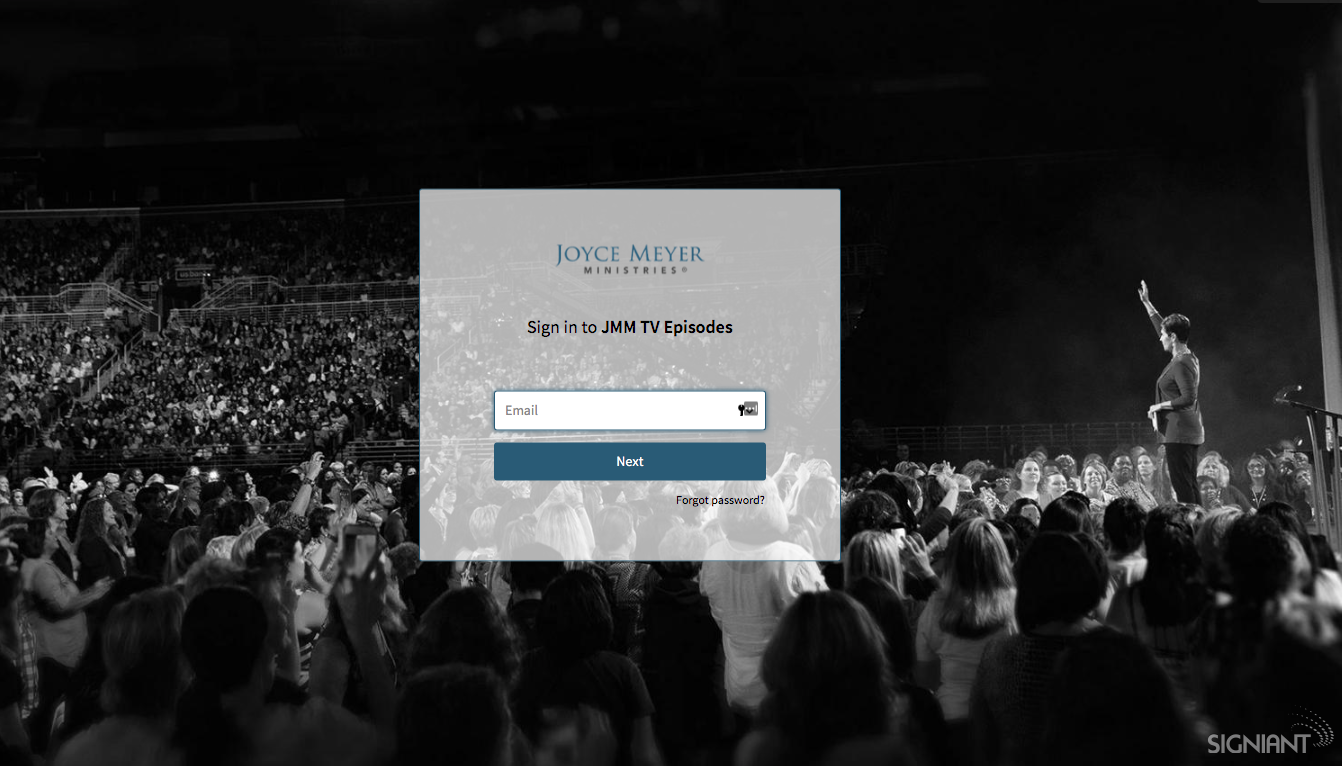On a Mission: Joyce Meyer Ministries Adopts Signiant Flight and Media Shuttle for Cloud Storage Archives and Fast File Transfer

Joyce Meyer Ministries is a Christian nonprofit organization that primarily uses television and online video outlets to reach their global audience. With Daily TV and Radio programs that air on over 1,000 television and radio stations in more than 90 languages as well as a historical archive of over 20 years of Meyer’s teachings, their Media Asset Management Department is responsible for a complex, high-volume content ecosystem.
Headquartered in St. Louis, MO, Joyce Meyer Ministries has nine international offices and 25 field offices, many of which center on the ministry’s humanitarian efforts. In 2017 alone, their members built over 875 wells in communities in need of clean drinking water, served over 28 million meals to hungry people at nearly 750 locations in 30 countries, and worked to aid refugees and victims of human trafficking in numerous countries around the world.
Many of their humanitarian projects have been captured in documentary format. However, a large majority of the video content that airs on the Daily TV show comes from teaching conferences conducted throughout the year around the U.S., and in-studio recordings at their St. Louis headquarters.
The Team
A critical function within the organization, the Media Asset Management Department takes care of all media forms from cradle to grave. “With such a substantial amount of production,” says Eric Grau who manages the team, “we solely exist to support the broadcast and creative services departments.”
The team is responsible for ingesting content ranging from video to images, staging, and organizing it on their onsite SAN (storage area network). They use Signiant’s Reach Engine for media asset management, pulling in all images and video, automatically tagging 50-60% upon ingest with other metadata fields tagged by hand after ingest.
Further down the pipeline, the team directly assists show editors with versioning the Daily TV program for different regions of the world, including North America, Australia, Europe, Africa and New Zealand. When finished content comes out of the editing suites, they are also responsible for delivering it to TV stations around the world. Finally, the team takes care of all present-day and historical archiving, including a climate-controlled vault, housing thousands of video tapes of Meyer’s teaching work spanning over 20 years.
The First Challenge: Archives
About two years ago, the Media Asset Management Department was facing a major challenge: How to archive incoming content and transfer the historical tape archives in a cost-effective manner that would scale to their large-volume data transfer needs?
“For any media organization,” says Grau, “it’s imperative to have two ways to archive material in case one becomes corrupt.” They had LTO, and still use it today, and were also using ODA (optical disk archiving). “ODA is a very robust system, but also very hands on and slow, not built for the amount of data that we needed to move to our deep archive,” says Grau. “We were literally burning and dragging individual files over to ODA, before placing them in the shelf unit.”
After the team had ODA underway for three years, it became clear that it was going to take an extremely long time to transfer content over. That’s when the team, along with their integration partner Chesapeake Systems, started searching for a solution to replace ODA, in particular, a file acceleration technology that they could use as a pipeline to Amazon S3 cloud storage.
The benefits of cloud storage were clear:
- Cost savings would be significant, especially after a few years and compared to ODA. Additionally, without the initial capital expenditure (cloud storage uses a pay-as-you-go model), the team could transition budget allocated for ODA rather than procure new funding.
- Elasticity and extreme capacities of cloud services can accommodate expanding requirements or large spikes and dips in data volumes.
- High availability of cloud storage allows access to the service at all times for archiving, but also if content needs to be pulled out for production purposes or disaster recovery.
- Built-in encryption and automatic updates ensure that their archive system keeps up with the security and technology requirements of the future.
However, one of the challenges of cloud services is that data still needs to move over IP to the cloud, which can be slow when moving large data volumes over standard IP transfer such as TCP or HTTP. While cloud platform providers do have solutions to the problem, such as procuring a dedicated network line, acceleration software is necessary to move high data volumes with efficiency.
Signiant Flight for Archiving
“That’s when I started building a business case along with Chesapeake Systems, our integration partner out of Baltimore, Maryland, to adopt a file acceleration technology to use as a pipeline to S3 while integrating everything into our Reach Engine MAM.” says Grau. “We did a ton of research, looked at Signiant’s competitor and also consulted with our contacts throughout the industry before deciding on the command line-based file acceleration option of Flight from Signiant.”
Physically, Grau’s team has a “fantastic integration” in the archive area with Flight. All of the footage that comes into their Reach Engine MAM, becomes a candidate based upon content type which is automatically tagged on ingest getting metadata fields set appropriately and is sent off to LTO (linear-open tape) and also uploaded to S3 through Flight. Flight’s ability to retain the folder pathway and directory structures of the onsite SAN, as passed on via Reach Engine, has truly provided a viable deep archive “mirror” in the cloud of their onsite SAN.
Throughout the first year using Flight, Grau and the team moved 40 TB of data to S3. It was so successful that they plan to send 600TB over the next two years. “Now, not only are we leveraging Flight and cloud storage in a very robust way,” says Grau, “but it is also providing substantial savings to the organization. The Flight technology has been so rock solid for us.”
Signiant Media Shuttle for Delivery
After Flight was such a huge success, Joyce Meyer Ministries also adopted Media Shuttle for transferring the Daily TV show to stations around the world. “There was a good robust clientele already using the Signiant product line,” says Grau, “and since the Daily TV show is the very core of what we do, it’s necessary to have a highly dependable means to deliver the show.”
The team set up Media Shuttle to use with their St. Louis office’s on-premises storage since all of the transcoding workflows for the Daily TV show happen there. Currently, their three active Media Shuttle portals have about 50 members and are set up in the share mode, so that partners can see and download only the files they need within the ministry’s on-premises storage file directory.
Compared to FTP, Media Shuttle’s speed has been a remarkable improvement, allowing for last-minute corrections to show footage and the ability to send updated files to specific broadcasters rather than everyone. For tracking purposes, they especially value the activity reporting capabilities, providing insight into who downloaded files and when.
The Media Asset Management Department has rolled out Media Shuttle as an FTP alternative in the U.S. and Canada with plans to transition their foreign stations in the next four to six weeks.
“Media Shuttle has given us the ability to manage our Daily TV show on a much greater level, giving us a lot more control and saving us a ton of time.” says Grau.
Summary
Joyce Meyers Ministries has witnessed a lot in the world of changing media formats and demand over the last two decades. With a huge historical video tape archive onsite and constant incoming content, the Media Asset Management Department needed a solution that scales to their needs.
Cloud storage like Amazon S3 was a logical choice but moving such large data volumes efficiently over the Internet requires acceleration technology. Signiant Flight not only provided that, it brought significant savings and additional advantages such as preserving file directory structures and folder pathways for a true “mirror” backup offsite in the cloud.
But they didn’t stop there. Seeing such a huge success with Flight, they also adopted Signiant Media Shuttle for the delivery of their Daily TV show to stations around the world, gaining greater speed and insight into their file transfers.
As the Joyce Meyer MAM department continues to use Flight for archives and to roll Media Shuttle out to more stations around the world, their efficiencies will only continue to rise. Allowing more time for what they really want to be doing — reaching their global audience.





